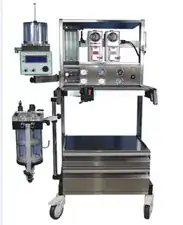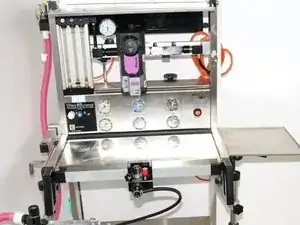Background and Identification
The Elite 615 was released to the public in 1995. This machine and its components must only be operated by trained medical professionals. It can be identified through the photo below.

The Elite 615 is best known for its 3 gas 3/5 tube anesthesia delivery system and safety features. It is a stainless steel machine that comes with integrated Anti-Hypoxic device gauges. These device gauges display and measure Air, O2, and N2O pressures of the pipeline and cylinders. It also has a reservoir for storing Oxygen and N2O cut off.
The Elite 615 is available in both the United States and Australia. ULCO Medical was acquired by Mindray Medical in 2013 and since then has stopped the production of the Elite 615, but they have manufactured a range of other anesthesia delivery systems in the past. These include the ULCO Anesthetic Suitcase, a portable field anesthetic machine, and the ULCO Signet 615, which, similarly to the Elite 615, is a hospital grade standing anesthetic machine for children and adults. The Elite 615 can be identified from the Signet 615 by the absence of a 5 tube backlit Rotameter.
Technical Specifications
- Weight: 70 Kgs. Not including Absorber or Vaporizer
- Dimensions: 1370 x 720 x 690mm
Standard Items Supplied with Elite 615
- Gas Circuits: Pipeline Nitrous Oxide and Oxygen (400kPa)
- Backbar: Back Bar components are all fitted with 23mm connectors
- Flowmeter: A 3 gas flowmeter for Oxygen, Nitrous Oxide, and Air
- Vaporizer Mounts: 2 Selectatec type mounts
- Common Gas Outlet: Contains Emergency Oxygen Flush (45L/min), Patient Safety Valve (50cm/H2O), and Male connector (22/15 mm)
- Oxygen Failure: An audio visual display warning system
- Drawer Units: 1 large drawer 150mm deep and 1 small drawer 100mm deep
For information regarding the Elite 615’s Optional Items, please view their user manual.
Source: Elite 615 User Manual
Additional Information
Troubleshooting
How do I attach the Emergency Oxygen Flush?
- Make sure that the Oxygen supply is ON
- Depress the flush button to check that the flow exists
- Connect a 2 Liter bag to the common gas outlet
- Depress the flush button
- Ensure that the bag fills within 3.5 seconds
How do I get the Flowmeters to work?
- Turn on the appropriate gas supply according to the label on the flowmeter tube.
- Rotate flow control valves anti-clockwise to open and check that the ball rotates freely
- Close the flow control valve and ensure that the bobbin or ball returns to the base of the flowmeter tube
- Repeat this procedure for each gas, turning off each gas supply after use
How do I reattach the Nitrous Oxide cylinder after replacing it?
- Connect nitrous oxide cylinder to yoke of pin index unit
- Check that nitrous oxide flow control valve is closed
- Turn on nitrous oxide cylinder and check relative gauge rise
- Turn off cylinder and check that the gauge pressure does not drop more than one division in a minute
- Turn cylinder OFF and check that the gauge does not drop more than one division in one minute. Should the gauge drop more than one division in one minute, locate the leak and repair.
Why isn’t the Nitrous Oxide circuit working?
It may be that the pipeline is attached incorrectly, the pressure is too low, or there is a leak.
- Check that nitrous oxide flowmeter flow control valve is closed
- Connect nitrous oxide pipeline hose to suitable supply and to the apparatus
- Check that pressure is 400kPa
- Turn off cylinder and check that the gauge pressure does not drop more than one division in a minute
Why isn’t the Oxygen circuit working?
It may be that the circuit is not attached correctly or there is a leak.
- Connect the cylinder to the yoke of the pin-index unit
- Check that the oxygen flow control valve is closed (do not force in any direction)
- Turn cylinder ON and check contents gauge – do not use if less than half full
- Turn cylinder OFF and check that the gauge does not drop more than one division in one minute. Should the gauge drop more than one division in one minute, locate the leak and repair
- Ensure that no leaks are present around the cylinders main valve or Bodok seal
- Connect oxygen pipeline hose to suitable supply and to the apparatus
- Check that the pressure is 400kPa
- Check for leaks and repair leaks as they exist
